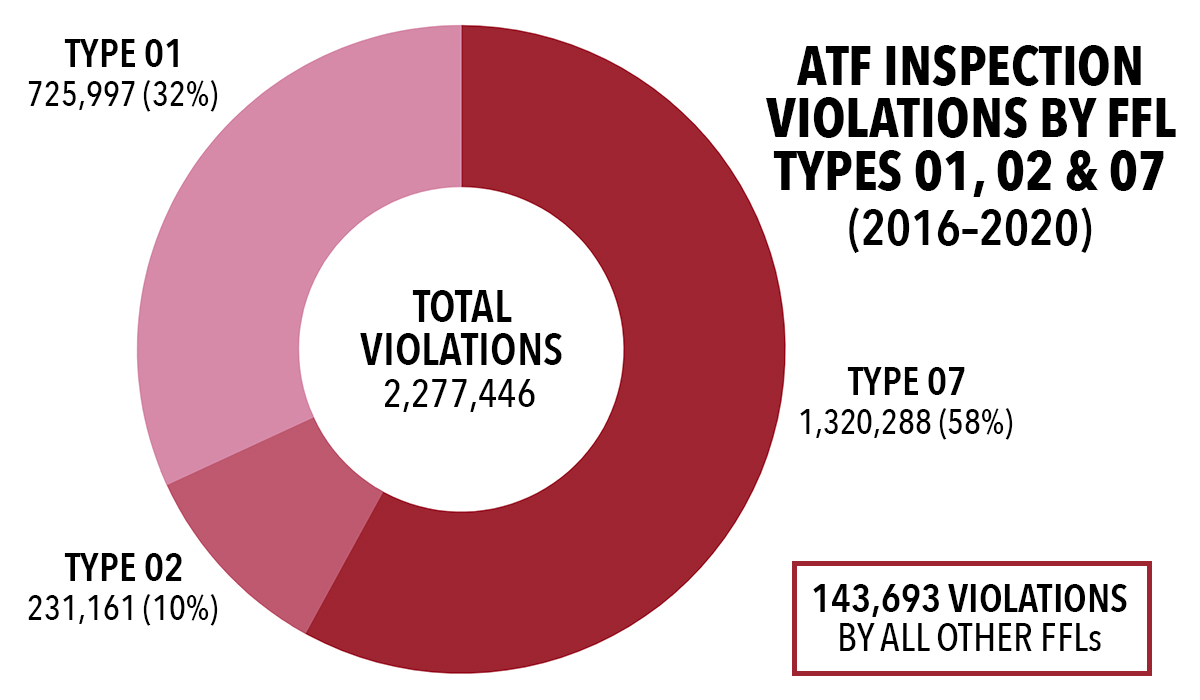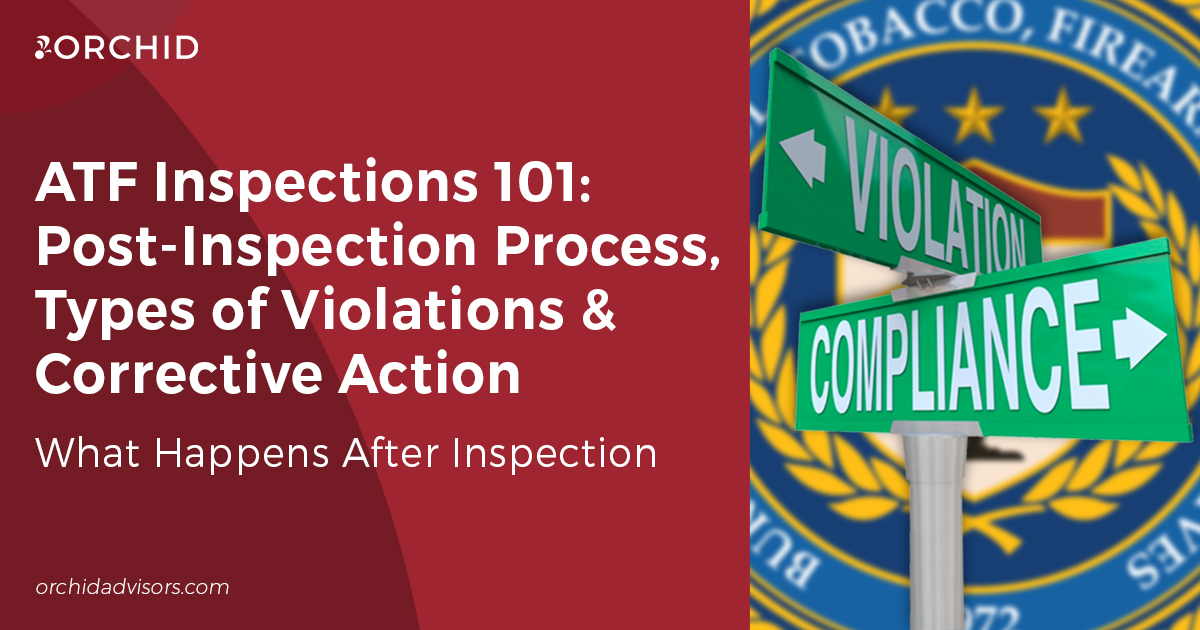In Part 1 of our ATF Inspections 101 series, we covered the basics of who conducts firearms compliance inspections, the purpose of inspections, when and where inspections take place, and how inspections are conducted. But what happens after the ATF has completed their inspection of your FFL?
If violations are found during an FFL inspection, the nature and extent of the violations will determine next steps. Below, we’ll address the post-inspection process, common and “willful” inspection violations, and the various levels of ATF corrective action.
Post-Inspection Process
Following an inspection, ATF industry operations investigators (IOIs) will sit down with licensees to review any violations found. If no violations are reported – congratulations, your FFL has done a great job maintaining compliance! However, if one or more violations are found in the examination of your operations, you will receive a Report of Violations. Exactly what it sounds like, the Report of Violations (“ROV”) notes any violations of law or regulation and outlines the discrepancy and requirements for corrective action.
ATF IOIs will then review firearm laws and regulations with the licensee and suggest voluntary actions or steps the licensee can take to improve compliance, answering licensee questions in the process. Later, the licensee will get a physical or digital copy of the signed ROV.
FFLs who receive citations may then be subject to a recall inspection at least one year after the initial inspection is completed. This follow-up inspection may be limited in scope to areas cited in the previous inspection or expanded to a full inspection to determine if the FFL has improved its compliance or remains non-compliant with firearms laws and regulations.
Inspection Violations
ATF inspections are primarily conducted to ensure FFL compliance with applicable federal, state, and local laws. While regulations can be complicated and confusing, it is the responsibility of the selected Responsible Person(s) and every employee to understand and abide by these laws and regulations to ensure the utmost compliance in day-to-day operations. However, no one is perfect, and mistakes happen.
Of 5,800 ATF inspections completed in 2020, only 56% of FFLs recorded zero violations – barely half of all firearms businesses – meaning the other 44% of firearm businesses recorded at least one violation. But not all violations are created equal.
Common Violations
While inspection violations can range in severity and operations segment, most tend to be related to the acquisition and disposition (A&D) Book and ATF documents and forms. Each year, the ATF provides a list of the 10 most frequently cited inspection violations.
In 2020, the most common ATF inspection violations were:
- Failure to maintain an accurate, complete or timely acquisition and disposition record of firearms
- Failure to maintain an accurate, complete or timely manufacture or acquisition record
- Failure to maintain an accurate, complete or timely licensee disposition record
- Failure to record firearm information on a Form 4473
- Failure to verify or record identification document on a Form 4473
- Failure by transferor to sign and/or date a Form 4473
- Failure to record NICS contact information on a Form 4473
- Failure to obtain a completed ATF Form 4473
- Failure to complete forms as prescribed
- Failure to report multiple sales or other dispositions of pistols/revolvers
When an inspection reveals regulatory violations are the result of inadvertence or administrative mistakes, and are not recurring or threatening to public safety, IOIs will usually work to assist the licensee in taking corrective actions to ensure those violations are not repeated and the licensee achieves full compliance. This doesn’t mean compliance should be overlooked or taken lightly, though.
Willful Violations
In the last year, the Biden administration has issued a new “zero tolerance” policy for willful violations by FFLs. While not defined in regulation, federal courts have held a “willful” violation occurs when an FFL commits the violation with an intentional disregard of a known legal duty or with plain indifference to their legal obligations.
Provided examples of willful violations include, but are not limited to:
- Failure to conduct a required background check
- Failure to verify and document buyer eligibility
- Transferring a firearm to a prohibited person
- Falsifying records, such as a firearms transaction form (ATF Form 4473)
- Failure to report multiple sales of handguns (ATF Form 3310.4)
- Failure to maintain records needed for successful firearms tracing
- Failure to account for firearms in inventory
- Failure to respond to a trace request
- Refusing ATF to conduct an inspection
Though not common, willful violations are often a basis for license revocation and have been the focus of the administration’s crackdown on “rogue” gun dealers. However, there are intermediate levels of ATF corrective action between Reports of Violations and revocation.

Graph of ATF inspection violations by FFL Types 01, 02 & 07 between 2016–2020
ATF Corrective Action
If inspection violations do not warrant a notice of revocation, the ATF has several ways to guide FFLs toward corrective actions for future compliance. In addition to issuing a report of violations, other measures include sending a warning letter and holding a warning conference (or meeting) with the FFL.
Between 2016–2020, ATF IOIs completed more than 48,000 inspections of FFLs. Of those, 11.9% received a Warning Letter, 4% received a Warning Conference, and a combined 0.6% were recommended for revocation or settled/surrended in lieu of revocation.
Each method of ATF corrective action is described below:
Report of Violations – Report describing violations cited, requiring appropriate corrective action and response by the FFL. A recall inspection is discretionary.
Warning Letter – Letter outlining violations found during the inspection, the need to correct the violations, and the potential for revocation of the license if the licensee does not come into compliance. A recall inspection is discretionary.
Warning Conference – Requirement to meet with the ATF Director of Industry Operations or Field Division Area Supervisor at an ATF office to discuss the violations, corrective actions, and potential for revocation. A recall inspection must be conducted.
Revocation or Denial of License Renewal – Active FFL license is revoked or application to renew license is denied. These actions are reserved for FFLs with severe or repeated violations that are deemed willful or disregard legal obligations.
In Part 3 of this series, we’ll dive deeper into the worst action, the revocation hearing, how to appeal, and what it means for your FFL.
Orchid FFL Protection
For over a decade, Orchid FFL compliance, operations and technology experts have helped firearm manufacturers, distributors and retailers take a proactive approach to ATF compliance.
Whether your firearms business is preparing for an inspection, currently under inspection, or responding to ATF corrective action – including license revocation – contact our in-house firearms law and compliance professionals to review your compliance plan, perform an onsite or remote mock ATF inspection, and protect your FFL.
More ATF Inspections 101
Part 1: Who, What, When, Where & How
Part 3 (Coming Soon)
Part 4 (Coming Soon)







0 Comments